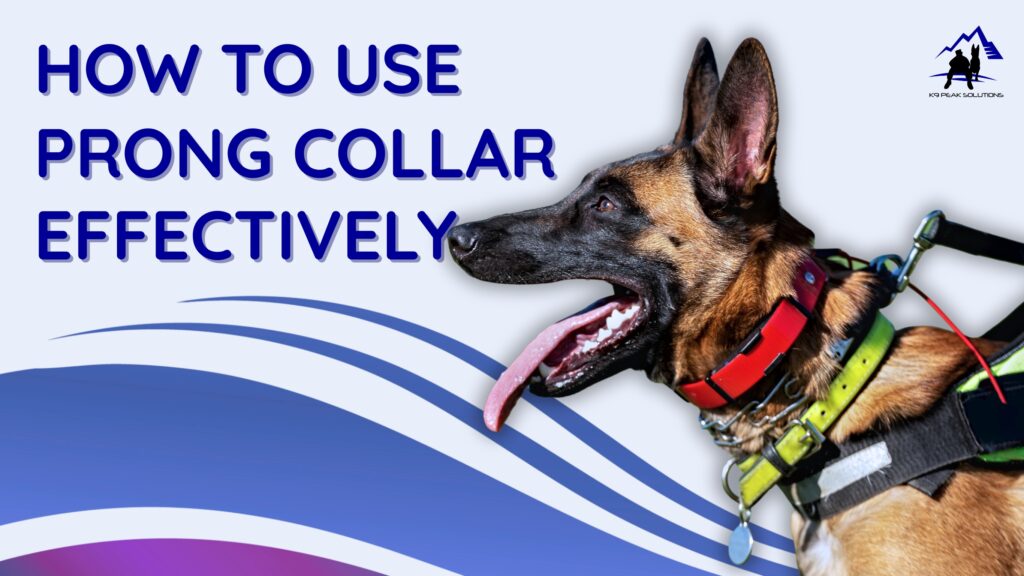
Prong collars, when used correctly, can be a valuable tool in training your dog, particularly for those who struggle with pulling or lack leash control. Whether your dog is pulling on walks, dragging you down the street, or making it difficult to manage, a prong collar can provide a solution that promotes better behavior without causing harm. In this chapter, we’ll explore how prong collars work, how to fit them properly, and how to use them effectively for training your dog.
Understanding the Prong Collar:
Prong collars are designed to apply pressure to a dog’s neck in a controlled manner. They’re often used for training dogs to stop pulling, but when used incorrectly, they can cause harm to your dog. It’s essential to understand how to use this tool to avoid hurting your dog and to ensure that the collar is providing the correct level of correction.
Here’s a breakdown of how to use a prong collar effectively:
Key Training Tips:
1. Proper Fitting:
One of the most critical aspects of using a prong collar is ensuring that it fits your dog correctly. The collar should be snug, but not too tight, as it needs to sit comfortably around your dog’s neck. A prong collar that’s too tight can cause discomfort and may even hurt your dog, while a collar that’s too loose will not function effectively.
To ensure a proper fit, place the prong collar just behind the dog’s ears, around the top of the neck, but not too close to the throat. The collar should be snug enough so that it doesn’t slip down but loose enough to avoid unnecessary pressure. It’s essential to check the fit regularly, especially as your dog grows or if they lose weight.
2. The Martingale Effect:
The unique feature of a prong collar is the Martingale effect, which is what makes it so effective. This effect happens when the prong collar tightens evenly around the dog’s neck when they pull. It’s important to note that this is not a choking mechanism—when used correctly, it simply provides a firm, consistent correction that is uncomfortable but not harmful.
The collar should only tighten when your dog pulls on the leash, which makes it a more humane alternative to traditional choke chains or harnesses that may be too harsh. The key is to apply a quick correction (a gentle leash pop) to give your dog the feedback they need to stop pulling. With consistency, your dog will learn that pulling on the leash results in discomfort and will adjust their behavior accordingly.
3. Choosing the Right Prong Collar Size:
Prong collars come in various sizes to accommodate different breeds and neck sizes. For dogs with thinner necks, smaller prong collars should be used to ensure a snug, secure fit. Larger dogs, especially those with thicker necks, may require a larger prong collar for effective control.
In the video, the trainer discusses the differences between prong collar sizes and provides examples of how to choose the right size for your dog. For example, small dogs, like Chihuahuas or Dachshunds, may require a 1.5mm prong collar, while larger dogs, such as German Shepherds or Rottweilers, may need a 3.0mm collar. Using the right size collar ensures that the correction is effective without causing any unnecessary pressure on the dog’s neck.
4. Proper Use of the Prong Collar:
Once the prong collar is fitted correctly, it’s important to use it properly. The collar should be attached to the leash via the swivel clasp, which prevents any shifting or twisting. Always ensure that the prong collar is positioned so that it can tighten evenly around your dog’s neck, but avoid pulling too hard or using it as a tool for constant pressure.
A proper leash pop (a quick pull and release on the leash) is the most effective way to use the prong collar. This mimics the natural way that mother dogs correct their puppies when they misbehave, providing an immediate and natural consequence for undesirable actions like pulling.
Why Use a Prong Collar?
Prong collars are ideal for dogs that tend to pull, especially those that are strong or difficult to control on walks. By using a prong collar correctly, you can teach your dog better leash manners and establish better control during walks. Unlike harnesses, which can encourage pulling, prong collars discourage this behavior by providing immediate, clear feedback when the dog pulls.
For many dogs, using a prong collar can help them become more attentive and responsive during walks, leading to a more enjoyable experience for both the dog and the owner.
Conclusion:
Using a prong collar effectively requires proper fitting, understanding of its function, and consistent training. When used correctly, a prong collar can help stop pulling, improve leash manners, and create a more manageable walking experience for both you and your dog. As with any training tool, consistency and patience are essential to success. By following the tips outlined in this chapter, you’ll be well on your way to having a well-trained, well-behaved dog on walks.



